Zero Carb Food List that Keeps Keto and Ketosis Simple
Keeping carbs low is the key to keto diet success. When carb intake is too high, we simply cannot enter ketosis and experience the unique benefits of keto.
However, this doesn’t mean that you have to rigidly track your carb intake at all times. In fact, many keto dieters are able to stay in ketosis by using one simple strategy: Eating mostly keto-friendly foods that have little to no net carbs (i.e., digestible carbs that reduce ketone production).
Although it may seem like carbs are hiding around every corner when you first start your keto weight loss journey, there are hundreds of delicious options that have zero or almost zero net carbs as well. To help you figure what these foods are and make keto as easy as possible, we’ve compiled the ultimate list of zero carb and almost zero carb foods for your convenience.
The Ultimate Zero Carb Food List
Technically speaking, almost every natural food contains at least a small trace of carbs. The only foods that literally have zero carbs are fats/oils (with some exceptions). For this reason, many of the foods on this “zero carb” list actually have trace amounts of carbs — at fractions of a gram.
To make our zero carb list, the particular food, beverage, or ingredient in question must meet these criteria:
- It contains less than one gram of net carbs per serving.
- It isn’t commonly consumed in large enough quantities for it to make a substantial impact on daily carb consumption.
If a specific item contains more than a gram of net carbs per serving or is typically consumed so much that it’ll cause carb intake to climb, then it will likely be found on the almost zero-carb list.
Most keto dieters can add these “zero” carb foods to there diet without worrying about the trace amounts of net carbs. For those of you trying to keep carbs as low as possible, however, make sure you track your servings as trace amounts of carbs can really add up at the end of the day.
We’ve broken the list down into multiple categories based on item type and practical use on the keto diet.
Here is a clickable table of contents for your convenience:
By Food Category
- Zero Carb Meats
- Zero Carb Seafood
- Zero Carb Fats and Oils
- Zero Carb Spices and Condiments
- Zero Carb Drinks and Beverages
- Zero Carb Sweeteners
- Zero Carb Alcohol
- Zero Carb Snacks
By Practical Use
- Zero Carb Foods to Increase Protein Intake
- Zero Carb Foods to Increase Fat Intake
- Zero Carb Foods to Increase Fat & Protein Intake
- Zero Carb, Low-calorie Foods to Increase Fiber, Vitamin, and/or Mineral Intake
Below our list of zero carb foods, you will find another list of “almost” zero carb foods that are a bit higher in carbs. This list includes many keto-friendly fruits and vegetables that will help you meet your fiber, vitamin, and mineral needs while you are restricting carbs.
This list of almost zero carb foods really expands your keto options without compromising on health or flavor. The foods are typically consumed at quantities that amount to more than a gram of net carbs when you are following a keto or low-carb diet, which is why they didn’t make the zero-carb list.
Here’s a clickable table of contents list for your convenience:
- Almost Zero Carb Seafood
- Almost Zero Carb Fruits and Veggies
- Almost Zero Carb Eggs and Dairy Products
- Almost Zero Carb Cheeses
- Almost Zero Carb Nuts and Seeds
- Almost Zero Carb Snack Options
- Almost Zero Carb Condiments and Dressings
Feel free to use our zero carb and (almost) zero carb food lists as a tool to help you keep carbs low without missing out on the flavor or worrying about hidden net carbs.
List of All Zero Carb Foods, By Food Category
To help simplify everything, let’s distill our zero carb list down to its simplest components:
Zero Carb Meats
Fresh meats:
- Beef
- Veal
- Lamb
- Pork
- Fowl
- Organ Meats (except for liver in most cases)
- Game Meats
- Exotic Meats
Processed meats*:
- Hot dogs
- Salami
- Sausages
- Bacon
- Ham
- Deli Meats
- Salted and cured meat
- Smoked meat
- Jerky, meat sticks, and other dried meat products
- Canned meat
* read labels carefully and avoid any carb-containing ingredients to minimize net carb intake
Zero Carb Seafood
Fresh, Canned, or Smoked*:
- Cod
- Flounder
- Sole
- Haddock
- Halibut
- Sardine
- Swordfish
- Flatfish
- Spanish Mackerel
- Grouper
- Tuna
- Trout
- Salmon
- Catfish
- Bass
*check ingredients for all canned and smoked varieties to avoid hidden carbs
Zero Carb Fats and Oils
- Extra virgin olive oil
- Coconut oil
- Grass-fed butter or ghee
- MCT oil
- Avocado oil
- Animal fats
Zero Carb Snack Options
- Pepperoni slices
- Pork rinds
- Bone broth
- Smoked fish
- Canned fish
- Canned meat
- Dried meat products
- Seaweed
Read ingredient labels carefully. Many prepackaged snacks come with added sugars or other carb-containing ingredients.
Zero Carb Herbs, Spices, and Seasonings
- Salt
- Black Pepper
- Most sugar-free Hot Sauces
- Mustard
- Oregano
- Rosemary
- Thyme
- Basil
- Chives
- Dill
- Chili Powder*
- Curry Powder*
- Cinnamon*
*Consume these spices in moderation because they have higher trace amounts of net carbs.
Zero Carb Sweeteners
- Stevia extract
- Monk fruit extract
- Pure erythritol
- Swerve sweetener
- Any sweetener blend that only consists of stevia extract, monk fruit extract, and/or erythritol
To minimize net carb intake, it is best to only use these sweeteners with no other added ingredients.
Zero Carb Drinks and Beverages
Most of your fluid intake should come from these sources:
- Water
- Coffee
- Tea
- Sparkling Water
- Club Soda
- Seltzer water
- Soda water
Consume these drinks in moderation:
- Sugar-free and carb-free energy drinks
- Diet drink mixes or drink enhancers with no added sugars
- Diet soda and other diet drinks
Zero Carb Alcohol
- Gin
- Rum (unflavored)
- Vodka (unflavored)
- Whiskey
- Tequila
- Scotch
- Bourbon
- Brandy
- Cognac
Alcohol can disrupt ketosis and impair your keto diet results even if your drinks have no carbs in them.
Zero Carb Options with High Fat and Low Protein
- Extra virgin olive oil
- Coconut oil
- Grass-fed butter or ghee
- MCT oil
- Avocado oil
- Animal Fats
- Pepperoni
- Beef Pemmican
- Ketoproof Coffee
- Ketoproof Tea
Zero Carb Options with High Protein and Lower Fat
- Leaner cuts of zero carb meats (skinless chicken breast, turkey breast, veal, etc.)
- Ground meat (turkey, chicken, beef, veal, pork, etc.)
- Leaner lunch & deli meats with no carb-containing fillers (ham, turkey, chicken, etc.)
- Game Meats (venison, bison, ostrich, caribou, elk)
- Exotic Meats (such as ostrich, camel, and emu)
- Smoked fish
- Canned fish (skinless, boneless, and canned in water for lowest fat option)
- Skinless canned chicken breast
Zero Carb Options with High Fat and High Protein
- Bacon
- Hot dogs
- Salami
- Sausages
- Fattiest cuts of meat (steak, ribs, lamb chops, short rib, pork belly, etc.)
- salted and cured meats (e.g., corned beef)
- Dark meat fowl with the skin on (e.g., chicken thighs and duck legs)
- Canned fish (in olive oil with skin on for most fat)
- Pork rinds
- Dried meat products (e.g., jerky, biltong, meat sticks)
Low-calorie Zero Carb Options
- Seaweed snacks
- Bone broth
- Shirataki noodles
There you have it — a condensed version of our zero carb lists to help you with keto grocery shopping and meeting your macronutrient (and micronutrient) intake targets.
Although it is possible to follow a diet is made up of only zero carb foods, we don’t recommend it. There is no reason to maximize carb restriction for health or for weight loss.
As long as you are in ketosis, you are technically on the keto diet, and as long as you are in a calorie deficit, you will lose weight. Following an almost zero carb diet is simply not practical, not sustainable, and not worth it for most people.
Plus, if you restrict carb as low as possible, you will miss out on the health benefits of keto-friendly fruits, vegetables, and cheese. Below, you can find a detailed list and breakdown of the items that were included in the list.
Zero Carb Meat List
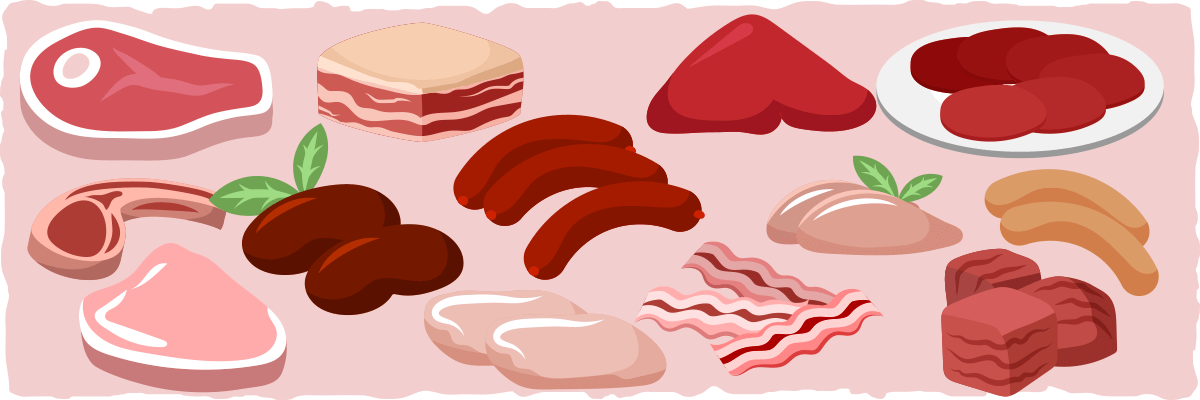
The following meats will be your go-to protein sources on the keto diet. Buy them fresh and with no added ingredients:
- Beef
- Veal
- Lamb
- Pork
- Fowl (turkey, chicken, duck, goose, hen, quail)
- Organ Meats*
- Game Meats (venison, bison, ostrich, caribou, elk)
- Exotic Meats (such as ostrich, camel, and emu)
*Be cautious when consuming liver as it contains glycogen (a source of net carbs). 100 grams of beef liver, for example, can contain up to 4 grams of net carbs. All other organ meats will only have trace amounts of carbs.
You can also find processed varieties of these meats with no added carbs:
- Hot dogs
- Salami
- Sausages
- Bacon
- Ham
- Deli Meats
- Salted and cured meat (corned beef)
- Smoked meat
- Jerky, meat sticks, and other dried meat products
- Canned meat
Read the ingredients label carefully. If you see any carb-containing ingredients, such as dextrose, starch, sugar, syrup, or maltodextrin, in a “zero carb” product, it may contain up to 1 gram of net carbs per serving. This is because food manufacturers can claim their product has zero carbs if it has less than one gram of carbs per serving.
For this reason, it is best to buy fresh meats and seafood and only consume processed meats if they have natural, carb-free ingredients.
Zero Carb Seafood List


Seafood is also a great source of protein for keto dieters. It will also help us meet our omega-3 fatty acid needs for the day so that we can experience their benefits to the fullest. This is why many dieticians and doctors recommend eating two or more servings of fatty fish, like sardines and salmon, every week.
Here is a list of fish that are zero carb when bought fresh and without added ingredients:
- Cod
- Flounder
- Sole
- Haddock
- Halibut
- Sardine
- Swordfish
- Flatfish
- Spanish Mackerel
- Grouper
- Tuna
- Trout
- Salmon
- Catfish
- Bass
You can also buy canned, smoked, and other processed varieties of these fish. As with processed meats, make sure there are no added ingredients that contain carbs.
The healthiest option is to buy wild caught salmon and sardines, canned or fresh without any other ingredients. These two fish tend to have the lowest mercury content along with a substantial amount of omega 3s per serving.
Zero Carb Snack List


If you want to curb those cravings without coming close to your carb limit, there are plenty of keto snacks you can rely on.
Here is a list of keto-friendly snacks with only trace amounts of net carbs:
- Pepperoni slices (~0.5g in 14 slices)
- Pork rinds
- Bone broth
- Smoked fish
- Canned fish
- Canned meat
- Preserved meat products (e.g., jerky, biltong, pemmican, meat sticks)
- Seaweed
This is as low carb as you can get when it comes to keto snacks. However, there are dozens of other keto-friendly snack options you can add to your diet as well. Check out our keto snack list for some more delicious ideas.
When purchasing any snack, make sure there are no additional carb-containing ingredients. Many of these products tend to have hidden sugars and fillers in them.
Zero Carb Oils and Fats


The easiest way to meet your fat needs without increasing your carb or protein intake is by adding healthy fats to your meals. However, Keep in mind that not all fats and oils will have positive effects on your health.
For best results, stick with these zero carb oils and fats:
- Extra virgin olive oil
- Coconut oil
- Grass-fed butter or ghee
- MCT oil
- Avocado oil
- Animal Fats (including lard)
Research indicates that the two best oils to use for high heat cooking are extra virgin olive oil and coconut oil (extra virgin olive oil has a slight edge over coconut oil). These oils are the most stable when exposed to heat and won’t break down into as many harmful compounds as other fats/oils.
Other vegetable, seed, and nut-based oils are less healthy for us and become toxic when exposed to high heat, so we recommend using them sparingly or avoiding them altogether.
Zero Carb Spices, Herbs, & Seasonings
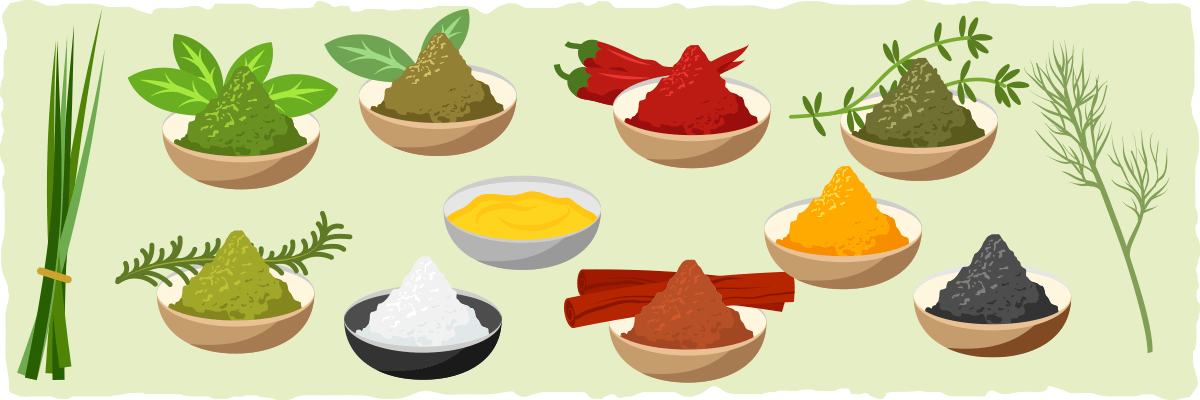

Unfortunately, many common flavor enhancers have hidden carbs and unhealthy ingredients in them. However, this doesn’t mean that keto eating has to be bland and boring.
In fact, you can make your keto meals into a culinary masterpiece with these zero carb seasonings:
- Salt
- Black Pepper
- Most sugar-free Hot Sauces
- Mustard
- Oregano
- Rosemary
- Thyme
- Basil
- Chives
- Dill
- Chili Powder*
- Curry Powder*
- Cinnamon*
* Limit these spices to a teaspoon. They have a bit more trace net carbs than the other spices listed.
Zero Carb Sweeteners


When choosing sweeteners, it is best to look at their carb content and health effects. This is because many common keto-friendly sweeteners can have a negative impact on various aspects of health despite being completely carb free.
After digging through the research and experimenting with different sweeteners, we’ve found these to be the healthiest zero-carb sweeteners:
- Stevia extract (liquid or solid with no other additives)
- Monk fruit extract (liquid or solid with no other additives)
- Pure erythritol (~0.2 grams of net carbs per teaspoon)
- Swerve sweetener (a 1 to 1 sugar replacement that doesn’t increase blood sugar levels)
- Any sweetener blend that only consists of stevia extract, monk fruit extract, and/or erythritol (with no other fillers or additives)
If you want to learn how to replace other sweeteners with these healthier options, you’ll find our comprehensive guide to keto sweetener substitutions to be a helpful resource.
Always be cautious of any low-calorie sweeteners that come in single-serving packets because they tend to have carb-containing fillers like maltodextrin and dextrose. For a closer look at the most popular sweeteners and their net carb content, check out our guide to the best and worst keto sweeteners.
Zero Carb Drinks & Beverages


While you are on the keto diet, make sure you are drinking plenty of fluids, especially when you first start restricting carbs.
To help you increase your fluid intake on keto, here are the best zero carb drinks you can have throughout the day:
- Water
- Coffee
- Tea
- Sparkling Water
- Club Soda
- Seltzer water
- Soda water
You can also increase your fluid intake with diet drinks. However, they may trigger cravings and other side effects that can make keto dieting more difficult:
- Sugar-free and carb-free energy drinks
- Diet drink mixes or drink enhancers with no added sugars
- Diet soda and other diet drinks (without any added sugar or sweeteners that increase your blood sugar levels)
If you’d like to see more detailed keto drink recommendations, check out our comprehensive guide to keto-friendly drinks & beverages.
Zero Carb Alcohol
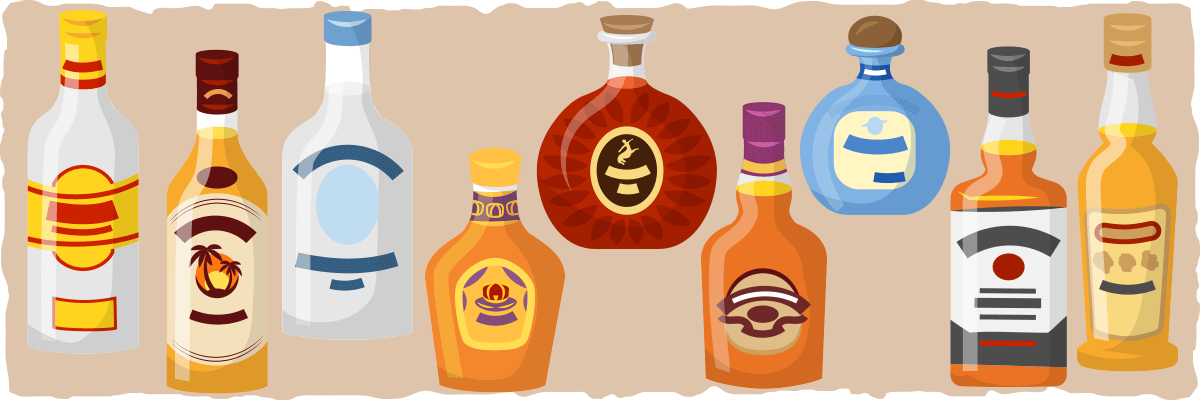

Everyone should use alcohol with caution, especially keto dieters.
Although some alcoholic drinks have virtually no net carbs, the alcohol itself will disrupt ketosis and fat burning until your body is able to fully process it.
Alcohol can even knock some keto dieters out of ketosis for several days until their livers can get back on track. Everyone is different, so monitor your progress and adjust alcohol intake if necessary.
If you’d like to enjoy an alcoholic beverage and minimize the risk of kicking yourself out of ketosis, it is best to limit yourself to a drink per day from this list:
- Gin
- Rum (unflavored)
- Vodka (unflavored)
- Whiskey
- Tequila
- Scotch
- Bourbon
- Brandy
- Cognac
Other common alcoholic beverages, such as beer and wine, are not on this list because they all contain net carbs.
For more info on how to incorporate alcohol into your keto diet without impairing your results significantly, check out our keto alcohol guide.
The Ultimate Zero Carb Foods List, Categorized by Practical Use
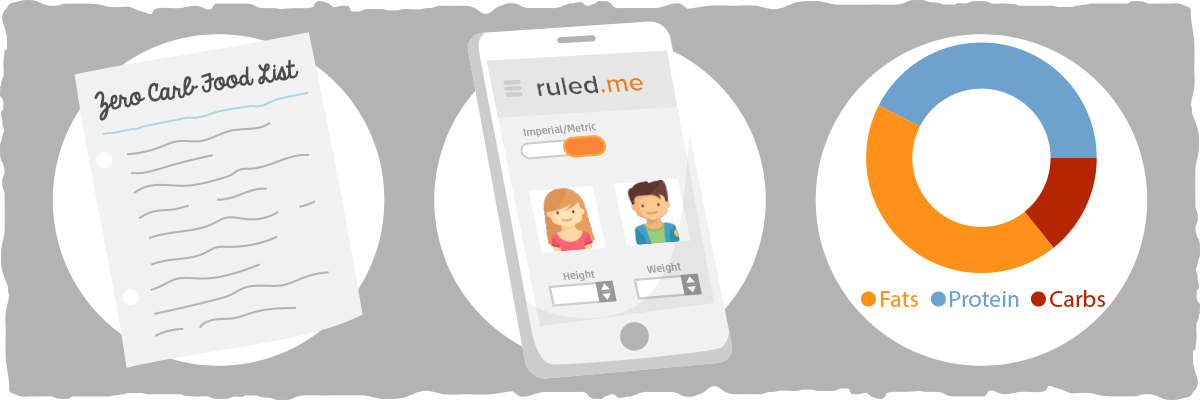

Now that you have an idea of what zero carb foods you can have from each popular food category, let’s organize them in a way that helps us meet our goals.
To help you figure out what zero carb foods you can use to reach specific keto diet targets, we took the foods from above and reorganized them into these categories:
- High-fat, low-protein zero carb foods to help meet your fat needs.
- High-fat, high-protein zero carb foods to help meet your fat and protein needs.
- High-protein, lower fat zero carb foods to help meet your protein needs (without getting too much fat).
- Low-calorie, zero carb foods to help meet your fiber, vitamin, and/or mineral needs.
If you are not sure how much fat or protein you should be aiming to eat yet, we recommend plugging your information into our keto calculator before moving on. This will give you a better idea of how much you need to eat from a macronutrient (i.e., carbs, fats, and protein) perspective.
High-fat, Low-protein Zero Carb Foods for Increasing Fat Intake
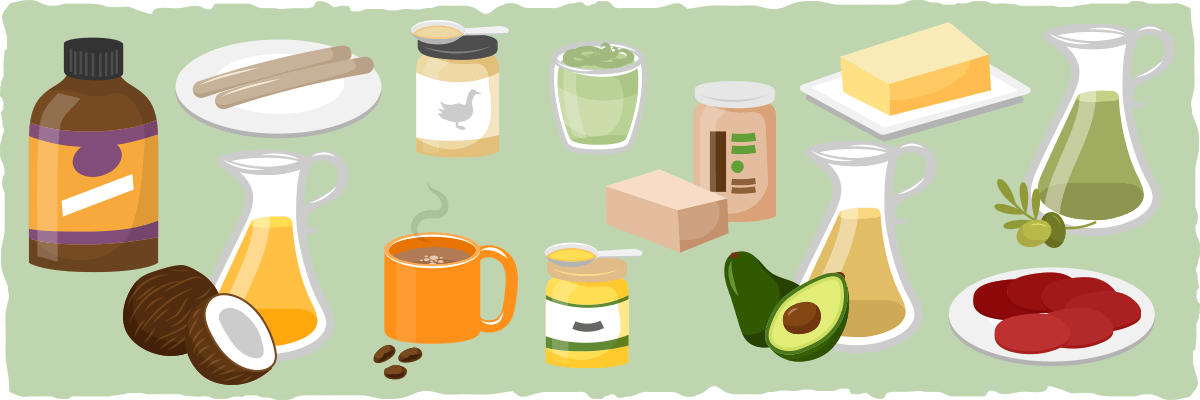

Below you will find a list of zero carb foods that are over 80% fat. Use these foods to increase your daily fat intake without having to worry about your protein and carb intake getting too high:
- Extra virgin olive oil
- Coconut oil
- Grass-fed butter or ghee
- MCT oil
- Avocado oil
- Animal Fats (including lard)
- Pepperoni
- Beef Pemmican
- Ketoproof Coffee (minimize your use of cream and vanilla extract to keep carbs as low as possible)
- Ketoproof Tea
Here are some simple ways to incorporate these high-fat, zero carb foods into your keto diet:
- Add healthy fats/oils to your keto meals by sneaking them into your sauces, smoothies, and soups and/or drizzling them on your keto meal or side salad.
- Snack on beef pemmican and pepperoni if you need a high-fat snack on the go.
- Have ketoproof coffee or tea with breakfast and/or lunch.
High-fat, Protein-dense Zero Carb Foods for Increasing Fat and Protein Intake
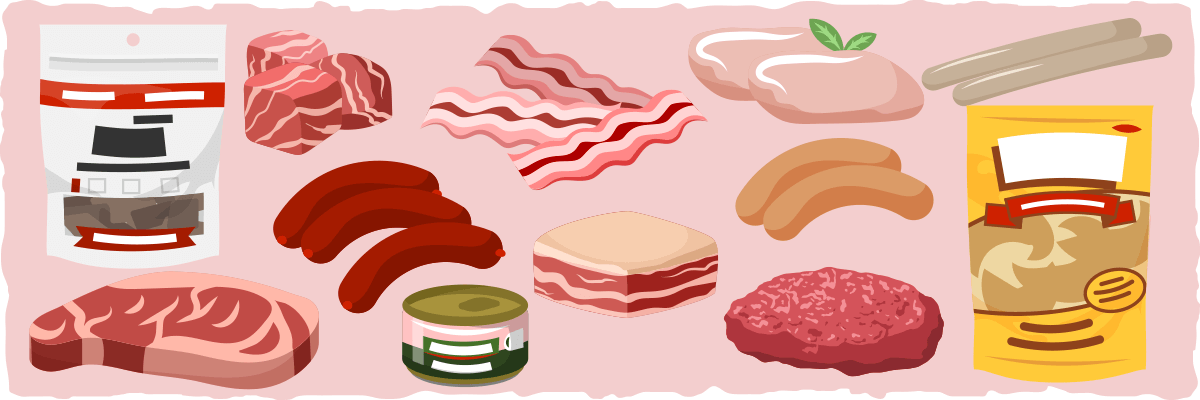

For those of you struggling to get enough protein and fat on your keto diet, try incorporating more of these foods:
- Bacon
- Hot dogs
- Salami
- Sausages
- Fattier cuts of meat (steak, ribs, lamb chops, short rib, pork belly, etc.)
- Salted and cured meats (e.g., corned beef)
- Dark meat fowl with the skin on (e.g., chicken thighs and duck legs)
- Canned fish (in olive oil with skin on for most fat)
- Pork rinds
- Preserved meat products (e.g., jerky, biltong, meat sticks)
The foods that are usually highest in fat (at around 70% fat) are found at the top. As you progress down this list, protein content increases to around 50% and fat content decreases to around 50%. These are all rough estimates, so make sure you look up the fat and protein content of any particular food you are concerned about.
There are two simple strategies you can use to increase your fat and protein intake:
- Eat more of the foods from the high-fat, protein-dense list. Focus on incorporating the higher fat options (at the top of the list) if you need more fat or the lower fat options (at the bottom of the list) if you need more protein.
- Combine high-fat, low-protein foods with high-protein, lower fat foods (from the next section) in your keto meals.
High-protein, Lower Fat Zero Carb Foods for Increasing Protein Intake
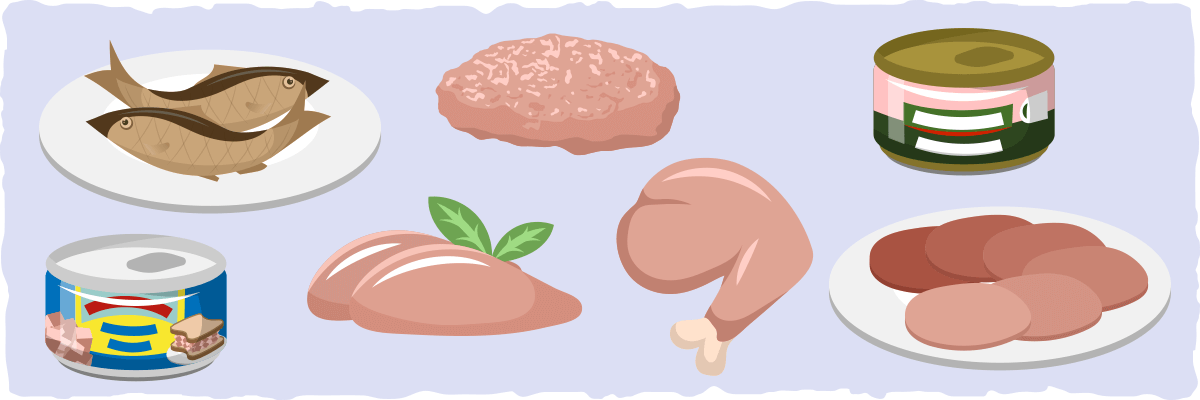

Getting enough protein in your diet is crucial for maintaining muscle mass, building muscle (if you are lifting weight), and reducing your appetite. If you are struggling to meet your protein needs, try adding these zero carb, high-protein foods to your keto meals:
- Leaner cuts of zero carb meats (skinless chicken breast, turkey breast, veal, etc.)
- Ground meat (turkey, chicken, beef, veal, pork, etc.)
- Leaner lunch & deli meats with no carb-containing fillers (ham, turkey, chicken, etc.)
- Game meats (venison, bison, ostrich, caribou, elk)
- Exotic meats (such as ostrich, camel, and emu)
- Smoked fish
- Canned fish (Skinless, boneless, and canned in water for lowest fat option)
- Skinless canned chicken breast
As a general rule of thumb, skinless white meat will always be higher in protein and lower in fat than dark meat with or without the skin. Furthermore, skinless meat will always be lower in fat than meat with the skin on.
This is why skinless chicken breasts have such a high percentage of calories coming from protein, while chicken thighs (i.e., dark meat with the skin on) are much higher in fat.
Low-calorie Zero Carb Foods for Increasing Fiber, Vitamin, and/or Mineral Intake


This will be the shortest zero carb list of them all because fiber and micronutrients (i.e., vitamins and minerals) are almost always found with net carbs in natural foods.
With that being said, if you are looking for a healthy keto food that won’t increase your calorie or carb intake substantially, you still have a few options:
- Seaweed Snacks. Seaweed is the best dietary source of iodine, which helps support your thyroid health. It also contains fiber and other vitamins and minerals, such as vitamin K, B vitamins, zinc and iron, along with antioxidants that help protect your cells. Look for seaweed snacks with only 2 to 3 ingredients: seaweed, salt, and some form of oil. The healthiest option will be a product that uses an oil from the zero carb fats/oils list above or no oil/fat at all. Regardless of what product you consume, make sure you have seaweed in moderation because eating excessive amounts will expose your body to potentially toxic levels of iodine and heavy metals.
- Bone Broth. Whether you buy it online or make it yourself, bone broth is a great, low-calorie addition to any diet. Bone broth contains essential minerals and plenty of health-promoting amino acids (that we rarely get enough of from fish and meat). To learn more about the health benefits of bone broth, check out this article.
- Shirataki Noodles. These slick noodles are a great zero-carb option if you are looking to add more fiber to your diet without increasing your net carbs intake. Feel free to add them to your keto meals or turn them into a keto-friendly pasta dish. Make sure you buy shirataki noodle products that only contain these three ingredients: Water, konjac flour, and limewater (calcium hydroxide). To learn more about these “miracle” zero net carb noodles, click here.
The scarcity of options in this category exposes us to the fact that most fibrous and micronutrient-dense foods come with some net carbs.
Fortunately, there are plenty of keto-friendly options for increasing your fiber and micronutrient intake that will not kick you out of ketosis. However, most of these options contain more than just a trace amount of net carbs, which is why they did not make it onto our zero carb food list.
The Almost Zero Carb Food List
Below, you will find a detailed list of almost zero carb foods that can help you with your macro intake.
Almost Zero Carb Seafood
When it comes to seafood in general, fish tends to have the lowest amount of net carbs followed by other types of seafood.
Here is a list of seafood that has some carbs, organized from lowest to highest net carb content:
- Shrimp (1g carbs per 100g)
- Lobster (1.27g carbs per 100g)
- Octopus (2.07g carbs per 100g)
- Clams (2.39g carbs per 100g)
- Scallops (2.41g carbs per 100g)
- Squid (2.92g carbs per 100g)
- Mussels (3.44g carbs per 100g)
- Oysters (3.73g carbs per 100g)


Almost Zero Carb Fruits and Vegetables
Leafy greens and cruciferous vegetables are your best option in this category. They are packed with vitamins, minerals, and fiber and won’t cause your net carb intake to climb substantially.
To give you a better idea of what the almost zero plant foods are, here is a list of ketogenic fruits and vegetables with the lowest net carb counts (organized from lowest to highest net carb content):
- Broccoli Raab (0.15g per 100g)
- Watercress (0.79g per 100g)
- Nopales (1.13g per 100g)
- Bok Choi (1.18g per 100g)
- Celery (1.37g per 100g)
- Spinach (1.43g per 100g)
- Mustard Greens (1.47g per 100g)
- Asparagus (1.78g per 100g)
- Radish (1.8g per 100g)
- Avocado (1.84g per 100g)
- Arugula (2.05 g per 100g)
- Zucchini (2.11g per 100g)
- Swiss Chard (2.14g per 100g)
- Mushrooms (2.26g per 100g)
- Kohlrabi (2.6g per 100g)
- Tomato (2.69g per 100g)
- Olives (2.8g per 100g)
- Eggplant (2.88g per 100g)
- Bell Pepper (2.9g per 100g)
- Cauliflower (2.97g per 100g)
- Cabbage (Green) (3g per 100g)
- Bamboo Shoots (3g per 100g)
- Cabbage (White) (3.07g per 100g)


Stick with the lowest net carb fruits and vegetables on this list to help you meet your fiber, vitamin, and mineral needs without worrying about going over your daily net carb limit.
To get the carb counts for each vegetable, check out our guide to the best low carb vegetables.
For more info on keto-friendly fruits check out this article: Best Low-Carb Fruits (and Which to Avoid).
Almost Zero Carb Eggs and Dairy
You’ll find a high-fat dairy product and eggs in most keto recipes. Here’s a quick breakdown of the almost zero carb varieties of these keto foods:
- Eggs (0.5g per large egg)
- Heavy Cream (0.5g per tablespoon)
- Half-and-Half (1-2g per tablespoon)
Where possible, try to opt for heavy cream to keep the carb content down and the fat content up. For replacing other dairy, like milk, try to go after nut or coconut based alternatives. These are becoming more common and usually contain only 1g carbs per cup.
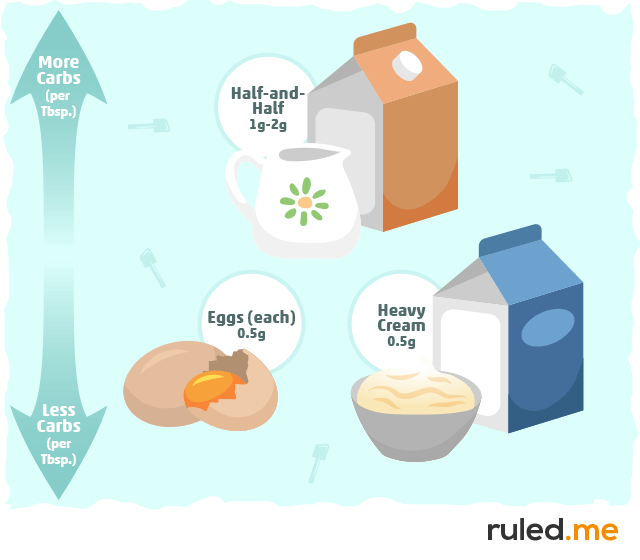

- Eggs. Eggs will be the most versatile keto food in your low-carb arsenal. You can have them fried, scrambled, poached, in omelets, in quiche, boiled, deviled, in keto baked goods, and in egg salad. Each type of egg will vary in its net carb content from .2 to 1 g. Be sure to check each carton. If it says it has 0 grams of carbs per egg, then count that as 0.5 grams of net carbs to play it safe.
- Heavy Cream. Most heavy whipping cream brands have a bit less than 1 gram of carbs per tablespoon, even if the packaging declares it has zero carbs. Make sure you check labels carefully – each brand of cream is very different. If the label claims it has zero carbs, then count that as 0.5 grams of net carbs to play it safe.
- Half-and-Half. Because it is typically made from equal parts whole milk and cream, half-and-half will always have more net carbs per tablespoon than heavy cream. Each half-and-half product will vary, but in general, they will contain 1-2 grams of net carbs per tablespoon.
Almost Zero Carb Cheeses
Most unprocessed, full-fat cheeses with no added flavors or ingredients have between 0 and 1 grams of net carbs in every 1-ounce serving. In general, hard cheeses will be the lowest in net carbs, and softer, creamy cheeses will be the highest.
Since most people use a lot of cheese on keto, the trace amounts of net carbs can really add up quickly. If you are having multiple servings of cheese per day, make sure you monitor those cheesy carbs.
Here is a list of the most popular keto cheeses with net carb content per 1 oz serving:
- Asiago (0.9 g)
- Blue (0.6 g)
- Brie (0.1 g)
- Camembert (0.1 g)
- Cheddar (0.3 g)
- Cream Cheese (1.1 g)
- Colby (0.7 g)
- Edam (0.4 g)
- Fontina (0.4 g)
- Goats (0.6 g)
- Gouda (0.6 g)
- Gruyère (0.1 g)
- Havarti (0.7 g)
- Mascarpone Cheese (0.9 g)
- Mexican Blend Cheese (0.5 g)
- Monterey (0.1 g)
- Mozzarella (0.6 g)
- Muenster (0.3 g)
- Neufchatel (0.1 to 0.8 g)
- Parmesan (0.9 g)
- Provolone (0.6 g)
- Ricotta (0.8 g)


Almost Zero Carb Nuts and Seeds
All nuts and seeds have some net carbs in them, but there are a few varieties worthy of the almost zero carb list:
- Raw macadamia nuts — 1.6 grams of net carbs per ounce (~12 macadamia nuts)
- Raw pecans — 1.2 grams of net carbs per ounce (~15 pecan halves)
- Raw brazil nuts — 1.2 grams of net carbs per ounce (~8 medium Brazil nuts)
- Chia seeds — 1.7 grams of net carbs per ounce (~2 tablespoons of whole chia seeds)
- Flaxseeds — 0.5 grams of net carbs per ounce (~2 tablespoons of whole flaxseeds)


It is relatively easy to eat a lot of nuts without realizing it, so make sure you eat them in moderation. Although they are a great way to meet your fat needs, the net carbs and calories can add up quickly if you are not careful.
Almost Zero Carb Snack Options


This list will expand your snack options without net carb intake climbing too high. Just make sure you eat them in moderation or else the carbs and calories will accumulate quickly.
- Homemade macadamia nut butter
- Raw macadamia nuts
- Raw pecans
- Raw brazil nuts
- String cheese
- Hard cheese
- Kale chips
- Zucchini chips
- Cheese chips
For a more comprehensive list of keto-friendly snack ideas, check out our keto snack list.
Almost Zero Carb Condiments and Dressings
Almost no carb condiments and dressings (with net carb estimates for each tablespoon):
- Soy Sauce (0.5g)
- Mayonnaise (0.23 g)
- Keto Tartar Sauce (0.32 g)
- Caesar Dressing (0.51 g)
- Keto-Approved Ranch Dressing (0.57 g)
- Italian Dressing (1.25 g)
- Roasted Garlic Chipotle Aioli (0.45 g)
- Low Carb Blackberry Chipotle Jam (1.17 g)
- Strawberry Chia Seed Jam (0.65 g)
- Keto Ketchup (1.62 g)
- Keto BBQ Sauce (1.69 g)
- Low-carb Thousand Island Dressing (0.38 g)
- Keto Guacamole (0.48 g)
- Vinegar (0.5g)
- Keto Pesto (0.73 g)
If you are looking for keto-friendly condiments and dressings in the grocery store, make sure you read the nutrition facts and ingredients label carefully. You will find that most of these products have sugars and carbs in them.
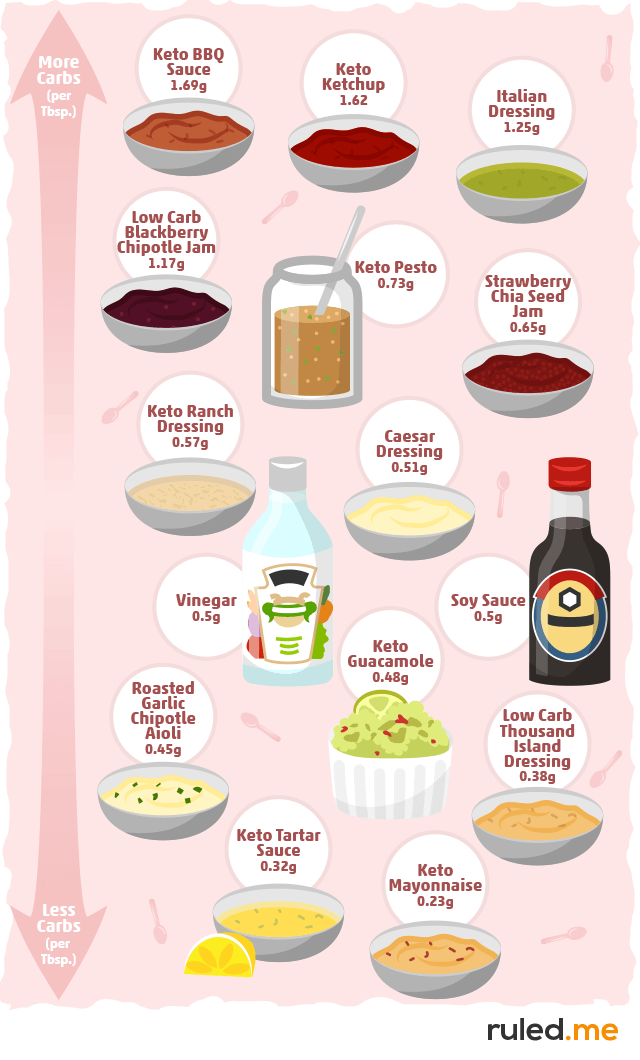

Putting Them Both Together — All Zero Carb and Almost Zero Carb Foods on One List
Below, you will find a combination of the almost zero carb and zero carb lists to help you with keto grocery shopping and meeting your macronutrient (and micronutrient) intake targets.


Carb Counting Secrets: How to Know What Foods Have the Lowest Net Carb Content
“Give a man a fish, and you feed him for a day. teach a man to fish, and you feed him for a lifetime.” — Lao Tzu
The zero carb and almost zero carb lists serve as the fish, so let’s learn how to fish by understanding the process behind calculating net carbs.
First, we need to examine the primary difference between carbs and net carbs. Technically, carbs are a general category of organic compounds that are found in food, consisting of carbon, hydrogen, and oxygen in a specific ratio. Depending on how digestible the carbohydrate is, it will be classified as either a dietary fiber or a net carb.
From a mechanistic level, a net carb is the type of carbohydrate that will be digested and used as the body’s primary fuel source. As our daily net carb intake goes up, our production of ketones goes down.
This is why the keto diet focuses so heavily on limiting net carb intake. By eating too many net carbs, your body simply will not be able to enter and sustain ketosis, which is the hallmark that sets keto dieting apart from other low carb diets.
To calculate how many net carbs are found in a particular food item, let’s take a look at a simple U.S. nutrition label:
The two values (and only two values) that you will be focusing on to calculate the net carb content of foods are “Total Carbohydrate” and “Dietary Fiber.” Total sugars and added sugars don’t matter as much because they only reflect a portion of the total net carbs found in the food.
To find the net carb content of any food item, you will subtract the number of grams of “Dietary Fiber” from the number of grams of “Total Carbohydrate.”
Simply put, you will plug the numbers you find into this formula:
Total Carbs – Fiber = Net Carbs
For the food label pictured above, you would calculate net carbs with this simple equation:
37 grams of total carbs – 4 grams of dietary fiber = 33 grams of net carbs per serving
Keep in mind that this indicates the number of net carbs per serving (which is 2/3 cup or 55 grams in this case).
For any food item that doesn’t come with a nutrition label, search for the nutritional info online or by using a calorie tracking app. You can find out how to use tracking apps to track your carbs and net carbs on keto by using this free guide.
(Note: If you live in Europe, Australia, or Oceania, the carb content on the label reflects the net carbs in a serving of that food, so you will not have to subtract fiber from that number because it already has been done.)
However, there is one important caveat. If you are trying to find trace amounts of net carbs, this simple math equation (total carbs – fiber = net carbs) will not help you uncover them. Food manufacturers aren’t required to include carbs on their labels if the product contains less than one gram per serving.
This means that low-carb food companies could make a product and market it as zero-carb by reducing the serving size and carb content until it has less than a gram of net carbs per serving, not by actually keeping net carbs out of the product.
It is actually possible to make “zero-carb” bread in this way. In fact, it has already been done.
Catching Hidden Carbs: Using Thin Slim Foods “Zero Carb” Bread as an Example
When looking for keto-friendly foods to add to your diet, you’ll find some products labeled as having zero net carbs or zero carbs. However, this doesn’t mean that there are absolutely no carbs in the product. What this really indicates is that it has less than one gram of net carbs per serving.
Although this is a small difference that won’t have a significant impact on your weight loss, these hidden net carbs can add up and reduce ketone production if you are eating multiple servings.
To help illustrate my point, let’s take a look at a popular zero-carb bread product made by ThinSlim Foods:
This product is marketed as having zero net carbs, and by using the net carb equation we learned earlier (7 grams of total carbs – 7 grams of total fiber = 0 grams of net carbs), their claims seem to hold up.
However, if we take a closer look at the label we find five ingredients (modified wheat starch, flaxseed meal, chicory root, yeast, and apple cider vinegar) that have trace amounts of net carbs in them. Also worth noting is that the serving size is relatively small, being one slice of a one-ounce piece of bread.
Altogether, this means that one slice of this bread is going to have between 0 and 1 grams of net carbs in it. If you are being cautious with your net carb intake, you may want to count each slice as having one gram of net carbs to play it safe.
You can use these same principles to figure out if any low-carb product you’re purchasing may have hidden net carbs in them. Some ingredients to look out for that are partially or fully digested and thus contribute trace amounts of net carbs are maltodextrin, dextrose, any variety of starch, Isomaltooligosaccharides (IMO), most sugar alcohols, and any other ingredient that has net carbs when you search for its nutrition info.
Being this stingy with your carb intake, however, is usually not necessary for getting into ketosis, improving health, and losing weight. If you are getting most of your calories from unprocessed and minimally processed foods (such as the foods found on the lists above), then the trace amount of net carbs from a serving or two of a keto-friendly product will have little to no impact on your results.
On the other hand, if you are eating multiple servings of keto baked goods, low-carb bars, supplements, or any other “low-carb”/“keto” product, then tracking your net carb intake from these products may be what you need to enter and maintain deeper levels of ketosis and experience the benefits of keto to the fullest.
In either case, it is always best to get most of your calories from whole, minimally processed foods. If you find yourself becoming paranoid about hidden net carbs and misleading marketing, take a step back from keto products and look for healthier, more reliable alternatives on the zero carb and almost zero carb food lists.
Practical Applications: How to Use the Zero Carb and Almost Zero Carb Food Lists for Keto Success
There are dozens of ways you can use this guide to help on your path toward keto diet success. Here are some practical suggestions you may find helpful:
- Use these lists as your meal planning and grocery shopping guide. The zero carb and almost zero carb food lists contain almost all of the lowest carb foods you can find, so you can use them to help you plan your weekly keto meals and shopping trip. Simply having 1-2 servings of meat or fish, 2-3 servings of almost zero carb fruit and veggies, and some zero carb high-fat foods with each meal may be all you need to lose weight, improve health, and sustain ketosis.
- Use these lists if you absolutely despise tracking net carbs and calories. Although tracking is a handy short-term weight loss tool , it can impair our relationship with food and make weight loss feel unnecessarily restrictive. If you’ve tried tracking and find it to be unhelpful, then try using these lists as your food menu to keep carbs low and your appetite even lower. Getting most of your calories from the foods on these lists may be all you need to lose weight and maintain ketosis.
- Use these lists to keep keto simple. If you feel like keto or low carb dieting is too restrictive, you may need to take a different approach to make it more sustainable for you. Instead of tracking carbs, following a strict meal plan, and/or testing you ketone levels all the time, a better strategy may be to use these lists to help guide your food choices and naturally keep carbs low without having to worry so much about tracking and testing. Make sure, however, that you are monitoring your progress every one to two weeks because it is still possible to gain weight or hit a weight loss plateau while eating keto-friendly foods.
- Use these lists to help you reach specific keto targets. Need a zero-carb, high-fat food? Check the list for some options. Want a high-protein food that isn’t too fatty? Add a food from the high protein, lower fat zero carb or almost zero carb list. Need to increase your fiber intake on keto? Check out the list of almost zero carb fruits and veggies or try adding shirataki noodles to your keto meals.
No matter what you decide to do, always keep your health and the sustainability of the diet in mind. The results you get mean nothing if your dietary approach is worsening your health & wellbeing or if it is too difficult for you to stick with for the long-term.
Instead of forcing yourself to follow a strict diet, focus on finding weight loss strategies that may improve your health and fit better with your lifestyle and experiment with them to see if they work for you. The zero carb and almost zero carb lists, for example, may be one of these weight loss tools that can help you reach your goals and gain more control over your health and body composition.
If you’d like to learn more about what you should and should not eat on the keto diet, check out these two free keto-friendly eating guides:
- Foods to Avoid on a Ketogenic Diet: What is Keto-friendly?
- Ketogenic Diet Food List: Everything You Need to Know
Sources
- Evaluation of Chemical and Physical Changes in Different Commercial Oils during Heating — Acta Scientific Nutritional Health
- ThinSlim Foods Love-the-Taste Bread Plain — Thin Slim Foods
- In vitro digestion and physicochemical properties of wheat starch/flour modified by heat-moisture treatment — ScienceDirect
Nutrition Info From:
The post Zero Carb Food List that Keeps Keto and Ketosis Simple appeared first on Ruled Me.


